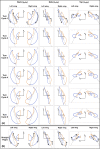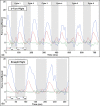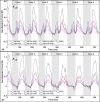Analysis of a 180-degree U-turn maneuver executed by a hipposiderid bat
- PMID: 33141874
- PMCID: PMC7608926
- DOI: 10.1371/journal.pone.0241489
Analysis of a 180-degree U-turn maneuver executed by a hipposiderid bat
Abstract
Bats possess wings comprised of a flexible membrane and a jointed skeletal structure allowing them to execute complex flight maneuvers such as rapid tight turns. The extent of a bat's tight turning capability can be explored by analyzing a 180-degree U-turn. Prior studies have investigated more subtle flight maneuvers, but the kinematic and aerodynamic mechanisms of a U-turn have not been characterized. In this work, we use 3D optical motion capture and aerodynamic simulations to investigate a U-turn maneuver executed by a great roundleaf bat (Hipposideros armiger: mass = 55 g, span = 51 cm). The bat was observed to decrease its flight velocity and gain approximately 20 cm of altitude entering the U-turn. By lowering its velocity from 2.0 m/s to 0.5 m/s, the centripetal force requirement to execute a tight turn was substantially reduced. Centripetal force was generated by tilting the lift force vector laterally through banking. During the initiation of the U-turn, the bank angle increased from 20 degrees to 40 degrees. During the initiation and persisting throughout the U-turn, the flap amplitude of the right wing (inside of the turn) increased relative to the left wing. In addition, the right wing moved more laterally closer to the centerline of the body during the end of the downstroke and the beginning of the upstroke compared to the left wing. Reorientation of the body into the turn happened prior to a change in the flight path of the bat. Once the bat entered the U-turn and the bank angle increased, the change in flight path of the bat began to change rapidly as the bat negotiated the apex of the turn. During this phase of the turn, the minimum radius of curvature of the bat was 5.5 cm. During the egress of the turn, the bat accelerated and expended stored potential energy by descending. The cycle averaged total power expenditure by the bat during the six wingbeat cycle U-turn maneuver was 0.51 W which was approximately 40% above the power expenditure calculated for a nominally straight flight by the same bat. Future work on the topic of bat maneuverability may investigate a broader array of maneuvering flights characterizing the commonalities and differences across flights. In addition, the interplay between aerodynamic moments and inertial moments are of interest in order to more robustly characterize maneuvering mechanisms.
Conflict of interest statement
The authors have declared that no competing interests exist.
Figures













References
-
- Norberg U. M. and V Rayner J. M., “Ecological Morphology and Flight in Bats (Mammalia; Chiroptera): Wing Adaptations, Flight Performance, Foraging Strategy and Echolocation,” Philos. Trans. R. Soc. B Biol. Sci., vol. 316, no. 1179, pp. 335–427, 1987, 10.1098/rstb.1987.0030 - DOI
-
- Pennycuick C., Bird Flight Perfomance. Oxford University Press, 1989.
-
- Ellington C. P., van den Berg C., Willmott A. P., and Thomas A. L. R., “Leading-edge vortices in insect flight,” Nature, vol. 384, no. 6610, pp. 626–630, 1996, 10.1038/384626a0 - DOI
Publication types
MeSH terms
LinkOut - more resources
Full Text Sources
Miscellaneous

